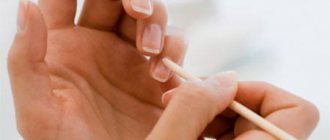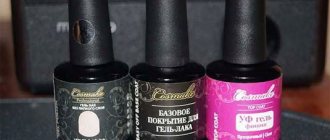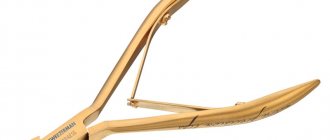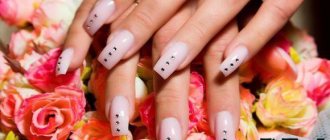Today, among the numerous manicure accessories, there is a special tool - an orange stick, the uniqueness of which lies in its versatility. It can be used to perform various procedures. Orange sticks are used both by professional nail technicians in salons and by lovers of self-manicures done at home. Using the device does not require any special skills, but the result is well-groomed and beautiful nails.
What is an orange stick
An orange stick is a thin stick made of wood. It is pointed at one end and beveled and flat at the other. The length ranges from 9 to 18 centimeters, and the thickness ranges from 3 to 5 millimeters. Its use helps to create a neat and gentle manicure.
Photo: What an orange manicure stick looks like.
If desired, you can give it the desired shape with a coarse abrasive nail file.
What is it for?
Orange sticks are an indispensable item in almost any area of manicure, from processing to design. With its help, the following procedures are performed:
- Cleaning your nails.
- Pushing back the cuticle.
- Cuticle removal.
- Removing gel polish.
- Extension.
- Design and decoration.
- Adjustment of coverage line, etc.
What are orange sticks made from?
The basis for orange sticks is the wood of the orange tree.
Its choice for the manufacture of these manicure tools is due to several important advantages:
- the wood is very dense and strong, it is unlikely that during work it will delaminate, crack or break;
- at the same time, the material is quite soft, there is no risk of injuring or damaging the nails when used carefully, especially at the sensitive base;
- has antibacterial properties.

Photo: Colored orange sticks
Cleaning your nails
This device is well suited for cleaning the area under the nails from accumulated dirt there. In this case, the sharp edge of the device must be passed under the nail several times. You can also clean the outer surface of the nail plate. Do not be afraid to injure the living dermis.
An orange stick will also be needed when removing gel and shellac at home and in salons. To perform this procedure, cotton wool is taken, from which sponges are made that fit the size of the nails. Then they need to be soaked in nail polish remover and placed on the nail plate. Cover the whole thing with foil on top. To prevent it from slipping, it is wrapped around your finger. Let it sit for 10-15 minutes. After this, the foil is removed, and the remaining gel and shellac are removed with this device. At the end, the nails are polished and lubricated with a cream that has softening properties.
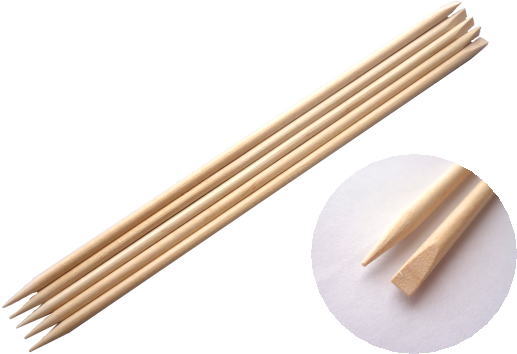
How to use
When caring for nails, an orange stick is used in almost every procedure. The exception is hardware manicure - where a special tool with a milling attachment is used to remove the cuticle.
To clean the inner surface of the nail plate, carefully rub the pointed end of the stick under the nail. If a tool is used for this purpose, it must be regularly washed to remove accumulated dirt or replaced with a new one more often.
To remove the cuticle from the nail plate, it is first softened with a special gel (remover), then carefully, without unnecessary pressure, moved with the beveled side of the tool to the base of the nail. Thanks to the material from which it is made, the stick does not tear the cuticle and does not damage the nail plate even in the thinnest and most sensitive area.
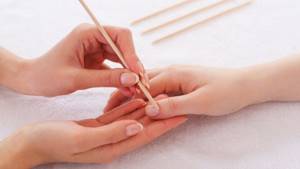
Using an orange tool you can remove gel polish . To do this, a special softening agent is applied to it. Then use the flat end to pry up a corner of the loose gel polish and carefully remove it from the nail. Unlike metal tools, after using a wooden stick, there are no scratches or damage to the nail.
nail extensions using a wooden tool. With its help, tips are glued, a mold is laid out from acrylic and biogel. In addition, the device is used to remove artificial nails: soften the acrylic, pry it off with the beveled end and carefully remove it.
In decoration and design, a wooden stick is indispensable: it is easy and convenient to apply small objects to the nail: rhinestones, sparkles, appliqués, stickers, sequins, beads, etc. With the sharp end you can paint your nails with varnish in various techniques: draw lines, patterns, put dots, etc.
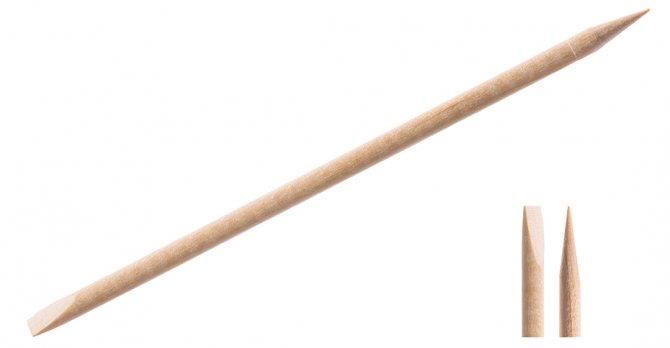
In addition, it can be used to correct minor defects when performing a manicure. For example, to straighten the line of varnish, remove varnish that has got on the skin. To do this, wrap the sharp end with a small piece of cotton pad, dip it in nail polish remover and remove excess or correct an uneven line.
How to remove cuticle
Removing cuticles with an orange stick is a simple procedure. It is carried out in several simple steps:
- You need to take a warm bath and hold your hands in it for several minutes. This will soften the skin.
- Use the beveled end of the tool to carefully move the skin to the base of the nail.
- Apply a special liquid to soften the cuticle - remover.
- After 5 minutes, the product is washed off.
- Use the pointed end of the stick to remove the cuticle, gently moving it along the nail growth line.
- As soon as the stick becomes dirty, it should be replaced with a new one.
- After completing the procedure, nourishing cream is applied to your hands.
- As soon as the cream is absorbed a little, the nails are degreased and varnished.
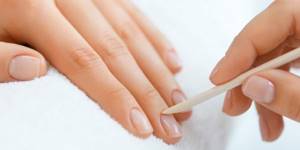
Features of selection and use
To perform a manicure with orange sticks or use them to carry out any stage in creating beautiful nails or cleaning them, you need to decide on the choice of this tool.
It’s not difficult to figure out what length and thickness of stick is right for you. You just need to buy a few pieces and try to do a manicure with them. The choice should be made on the option that is suitable for specific nails, depending on their shape, condition and thickness.
Having thin nails and delicate cuticles, it is better to use plastic models, although they are considered not very comfortable.
When purchasing a variety you like, you need to pay attention to its price, as well as the place where you buy it. Such high-quality goods can only be sold in specialized stores. Otherwise, the product will be too fragile or may delaminate.
Features of use:
- This is a personal instrument and cannot be re-used by others.
- After completing the procedure, the stick must be thrown away, because due to the characteristics of the material from which it is made, microbes quickly develop in it.
- Buy a package of this product right away, because one stick will not be enough to create a beautiful manicure. This will save time on purchasing missing products.
- If necessary, the shape of such a tool can always be corrected by having an abrasive file on hand.
How much do orange manicure sticks cost?
Everyone who does manicures should always have orange sticks in sufficient quantities, so it is more profitable and convenient to buy them not individually, but in a whole package. The cost ranges from 19 to 350 rubles depending on the length and number of pieces. This manicure tool is sold in almost all stores, including large chain supermarkets. You can also purchase it in online stores, often at a very attractive price.
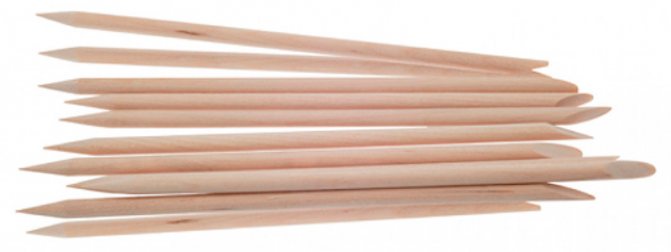
What should you remember when working?
Recommendations for use:
- Sticks should be thrown away after use. Orange wood absorbs moisture well and cannot be sterilized, so reusing the instrument is undesirable. For the same reason, you need to buy a set of several pieces.
- You cannot use chopsticks after other people. Manicure tools can carry bacteria and even life-threatening viruses (hepatitis, HIV, etc.). Before doing a manicure, you should make sure that no one has used a stick (especially if you go to unfamiliar salons). If the master assures that the instrument has been sterilized, you should not believe it. The orange tree cannot be disinfected.
- You can customize the tool to suit you. If the original shape is not suitable, the ends should be processed using a nail file with a hard abrasive surface. You can modify both the pointed and beveled sides of the tool.
- The tip needs to be processed. When creating nail art (for example, when laying rhinestones and beads), the sharp end should be moistened with a small amount of glue or clear nail polish. In this case, the decoration will stick to the tip, and you can easily put it in place.
What can you replace an orange stick with?
An orange stick is a convenient tool and is perfect for most manicure jobs. But if for some reason it is not at hand, you can use other devices. It all depends on the type of procedure ahead:
- To push back the cuticle, use a metal manicure shovel - a pusher.
- It is recommended to remove the skin with small sharp scissors or tweezers.
- For extensions, you can use thin nail tweezers or a pusher.
- A special wax pencil will help you decorate your nails with beads, sequins or rhinestones. It is considered even the best decoration device.
- The design can be easily done with a needle, thin brush or dots.
- To clean the inner surface of the nail from dirt, you can use a regular nail file, a metal spatula (its reverse side) or a special pencil with a whitening effect.
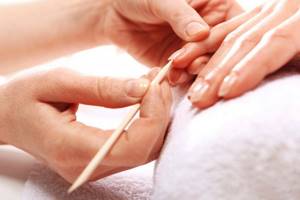
Using a durable and convenient orange stick for manicure is easy. The versatility of the tool allows it to be used in various procedures, from cleansing to design and decoration. Manicure tools made of wood are absolutely safe for health, do not injure or damage the nail plate and skin, and are suitable for both professional and home manicure. The low cost, especially if you buy a whole package, allows you to easily purchase them as needed and always have them on hand.
Working with the cuticle
The blunt end of the device allows you to easily push back the cuticle. During this procedure, it will not be damaged at all, and since there is no need to trim the dermis, it will not be injured, and burrs will not form on it. You can do this painless and easy procedure yourself at home. To remove cuticles with an orange nail stick, you need to follow some rules.
First you need to slightly warm the water, to which it is advisable to add chamomile decoction. You need to lower the fingers of one hand there for 5 minutes. During this time, the skin will become soft. After it softens, the cuticle is carefully pushed away from the nail plate. At the same time, you need to raise it a little.
A liquid or gel remover is applied to the prepared dermis using a special brush. After 5-7 minutes have passed, the surface of the nail must be cleaned of this product, and the cuticle must be removed with the sharp end of an orange stick.
If it becomes clear that this device has become a little dirty, you need to throw it away and continue the procedure with a new stick. When the whole process is completed, it is recommended to apply a small layer of emollient to clean nails. Then the same actions are carried out with the second hand.
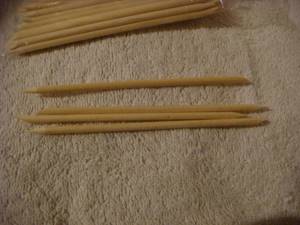
Recommendations for work and useful rules
How to use orange peel sticks? Some important tips, rules and recommendations for competent work will help:
- You should not use old sticks for manicure, as they accumulate moisture and harmful microorganisms. The stick should be dry and hard. If it is not possible to get a new stick, the edges of the tool can be sharpened with a highly abrasive file or buff.
- When pushing back the cuticle and cleaning out the pterygium, you do not need to go deep under the hood. One careless action can damage the nail growth area, which will subsequently lead to lumpiness of the plate and even cracks.
- If necessary, treat the stick with an alcohol disinfectant spray - it does not soften the material and evaporates quickly.
- You need to push back the cuticle with the beveled end, and minor manipulations are carried out with the pointed part. In this case, the cut can be adjusted to the shape, for which the stick is often cut with pliers or filed.

Citrus stick is indispensable for soft, unedged manicure.
Additional Information! It is not recommended to use orange stick more than three times. Tools should be stored in a dry and dark place.
Delete or move?
When it comes to orange sticks, the question of choosing between removing or pushing back cuticles comes up. Most nail artists consider unedged manicure the best option for sensitive hands. Their opinion is due to a number of reasons:
- when the cuticle is pushed back rather than cut off completely, its growth slows down because regeneration processes do not occur;
- when cut, the body starts the recovery process, which is why the cuticle grows several times faster;
- the use of emollients, oils and acids contribute to the thinning of the cuticle and dead skin cells;
- moving away helps eliminate trauma and, as a result, reduces the risk of infection;
- even the pulled back cuticle continues to protect the growth zone, due to which the nail remains strong, moisturized, and even.
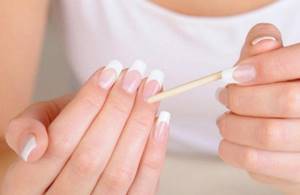
An orange stick will help avoid cuts when processing cuticles
However, many experts advise not to give up edged manicure, but to alternate it with unedged manicure.
Areas of application
It is difficult to imagine a more multifunctional tool than a wooden stick. It can be used in extensions, design and manicure. The tool is most often used in the following areas:
- Cleaning your nails. In this case, we mean removing dirt from under the free edge of the nail. To do this, use the pointed end of a stick;
- Pushing the cuticle is one of the main areas of use. An orange manicure stick, as in the photo, is very popular when performing unedged European manicure. This is one of the safest tools for this purpose, as it will not damage the nail plate. Not the cuticle itself;
- Cleaning the cuticle from the nail plate after it has been softened with a remover is also easily done with this tool. The ptegirium can also be easily scraped off. This tool is preferred for these purposes also for security reasons;
- This tool is also indispensable when doing nail extensions. They can be used when gluing tips and forms. In addition, they are sometimes used directly for laying gel on forms;
- Removing shellac and gel is also not complete without such a stick. After the coating material is softened by special means, its remains are scraped off with such a stick;
- Decorating nails is also often not complete without the use of sticks. They are used for applying and moving small elements across the plate, smoothing stickers, etc. Some even manage to use them for painting.
Many other ways to use this tool in manicure remained unmentioned. For example, such a stick can replace a needle when painting on wet varnish. If you buy sticks with a pointed cone, you can also replace them with medium-diameter dots.
How to choose the right size sticks?
Orange sticks come in different shapes and sizes. To choose the right wand, purchase several variations and try working with them. So you will understand which one suits you best and fits better in your hand. In addition to their shape, the sticks differ in their decorative coating: multi-colored or simply “varnished” to resemble wood.
The length of the sticks ranges from 9 to 18 centimeters, and the thickness from 3 mm to 5.
In addition to wooden sticks, there are plastic “orange sticks” on sale, but they do not glide as much as wooden ones and can injure the skin around the nail if they do not have a rubber tip.
Manufacturing
Orange sticks appeared in the second half of the 20th century in France and quickly gained popularity due to their high versatility and ease of working with them. An orange manicure stick is a fairly cheap tool compared to others, because the price of a set can range from 20 to 200 rubles. It depends on the number of sticks, their size, length, and decorative elements.
Why did they choose the orange tree to make manicure tools? It combines a number of excellent properties and useful qualities. Its wood is quite dense and strong, which prevents it from breaking or absorbing too much liquid, and the stick does not delaminate when finished. At the same time, the wood is soft, which means it does not injure the nail. The antiseptic properties of this wood reduce the likelihood of inflammation developing at the site of microtraumas.
Metal cuticle spatula
In the makeup bag of many girls you can find another tool, this time a metal one. The ease of use of a manicure pusher has made it very popular among women. The ends of the metal rod come in different shapes. The edge can be made in the form of a spear, hatchet or spatula. There are models with a trimmer at the end - a knife reminiscent of a slingshot. The photo shows several varieties of pushers.
A high-quality instrument is made of medical steel. Its blade is quite sharp and does not require pre-sharpening. A pusher or scraper is easily disinfected, which is why it is popular among manicurists. The metal tool can perform all the functions of an orange stick. But it is worth noting that you should use a manicure scraper very carefully, because a steel spatula can significantly damage the nail plate. To reduce possible harm, it is better to use models with rubber tips.
From the history of citrus stick
A useful tool made from citrus tree wood was invented in France.
In 1830, the last French king, Louis Philippe, developed inflammation on his finger due to a deep hangnail. The court physician was ordered to eliminate this scourge. After the doctor successfully removed the hangnail, he created a universal set for the care of nails and hands especially for such cases - this was the first manicure set. The world's first orange stick was included there.
This instrument was already popularized by the doctor’s niece. At first, she herself used her father’s invention, then she adopted his skills and made manicure an important part of personal hygiene in court circles. Therefore, already at the beginning of the 20th century, citrus sticks, like other devices (files, hand creams), were sold in cosmetics and perfume stores and in European supermarkets.
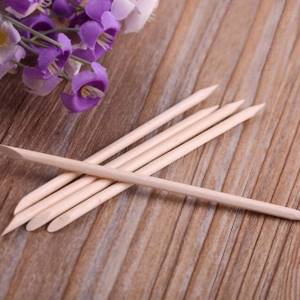
The instrument has a long history: it appeared in the first half of the 19th century.
Selecting the required tool
To push back the cuticle, use different tools: a metal or rubber spatula, as well as an orange wooden stick. The latter is the most popular and basic tool of European manicure. A double-sided orange stick is a disposable item, averaging 9–18 cm in length, used for pushing away. Its structure is soft, dense, and has antiseptic properties. This is a thin stick with pointed and flat ends. Unlike others, this instrument is the most hygienic and less traumatic. Doesn't scratch the nail, doesn't tear the cuticle. You can change the shape of an orange stick using a coarse abrasive file. To move away, use the blunt tip of the stick, and the sharper tip is used to clean the dirt under the nails, remove acrylic or apply decor.
A reusable spatula made of medical steel with different edges is the most common tool in manicure. It is often called a pusher (scraper). It may well replace an orange stick, as it adequately performs the same functions. Does not require sharpening, but must be disinfected by boiling or treatment with aseptic means. When using a metal tool, the likelihood of nail damage increases significantly, so spatulas with rubber tips are often used.
New products designed for working with cuticles include a special pencil. Multifunctional tool. It is also used to move back the preungual skin fold. This is done using a capillary. At the same time, oil is applied to the skin roll that is moved away. After this, the shape of the nails is created using the pencil cap. The tool is quite safe and suitable for non-professional use.
Which is better: moving away, dissolving or removing
There are three known ways to remove the cuticle (skin pre-nail fold): cutting, pushing back, dissolving. Pushing back is present in any type of manicure. But if in the trimming version this is one of the stages on the way to cutting off the skin ridge, then in is the main condition. From an aesthetic point of view, of course, circumcision during manicure looks more tempting. The length of the nail increases, and the varnish on it looks beautiful, emphasizing its well-groomed appearance.
For those with thick, thick cuticles, the trimming method is a real salvation in the full sense of the word. It is necessary for the prevention of inflammatory processes, the formation of hangnails, and the appearance of other problems of the nail plate. But circumcision stimulates increased growth of the skin fold and is sometimes accompanied by cuts or microtraumas, which, in turn, can also provoke an inflammatory process.
Dissolution allows you to remove the cuticle using an expensive but effective remover. It is considered environmentally friendly, but requires the correct approach and application. Despite the speed and effectiveness, the use of the product has a number of nuances. If you overexpose it or use it frequently, you can injure the bed of the nail plate, and over time even destroy it. Therefore, the optimal amount of use is no more than 2 times a week.
Against this background, pushing back looks like the most gentle, harmless method that eliminates the occurrence of infections with inflammation. The presence of a skin roll means protecting the nail from external influences and providing the necessary nutrition and hydration. In addition, retraction slows down the growth of the skin pre-nail fold. But the most interesting observation is that the polish on the nail plate with uncut cuticles lasts better and longer.
